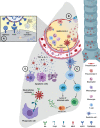A review: Antibody-dependent enhancement in COVID-19: The not so friendly side of antibodies
- PMID: 34632844
- PMCID: PMC8512237
- DOI: 10.1177/20587384211050199
A review: Antibody-dependent enhancement in COVID-19: The not so friendly side of antibodies
Abstract
The coronavirus disease 2019 (COVID-19) pandemic, caused by severe acute respiratory syndrome coronavirus 2 (SARS-CoV-2), represents an unprecedented global public health emergency with economic and social consequences. One of the main concerns in the development of vaccines is the antibody-dependent enhancement phenomenon, better known as ADE. In this review, we provide an overview of SARS-CoV-2 infection as well as the immune response generated by the host. On the bases of this principle, we also describe what is known about the ADE phenomenon in various viral infections and its possible role as a limiting factor in the development of new vaccines and therapeutic strategies.
Keywords: ADE; COVID-19; SARS-CoV-2; antibody-dependent enhancement; vaccine.
Conflict of interest statement
Figures


Similar articles
-
Waning antibodies from inactivated SARS-CoV-2 vaccination offer protection against infection without antibody-enhanced immunopathology in rhesus macaque pneumonia models.Emerg Microbes Infect. 2021 Dec;10(1):2194-2198. doi: 10.1080/22221751.2021.2002670. Emerg Microbes Infect. 2021. PMID: 34736354 Free PMC article.
-
Role of antibody-dependent enhancement (ADE) in the virulence of SARS-CoV-2 and its mitigation strategies for the development of vaccines and immunotherapies to counter COVID-19.Hum Vaccin Immunother. 2020 Dec 1;16(12):3055-3060. doi: 10.1080/21645515.2020.1796425. Epub 2020 Aug 26. Hum Vaccin Immunother. 2020. PMID: 32845733 Free PMC article. Review.
-
Characterization of SARS-CoV-2-specific humoral immunity and its potential applications and therapeutic prospects.Cell Mol Immunol. 2022 Feb;19(2):150-157. doi: 10.1038/s41423-021-00774-w. Epub 2021 Oct 13. Cell Mol Immunol. 2022. PMID: 34645940 Free PMC article. Review.
-
Two Different Antibody-Dependent Enhancement (ADE) Risks for SARS-CoV-2 Antibodies.Front Immunol. 2021 Feb 24;12:640093. doi: 10.3389/fimmu.2021.640093. eCollection 2021. Front Immunol. 2021. PMID: 33717193 Free PMC article.
-
Insights into COVID-19 Vaccine Development Based on Immunogenic Structural Proteins of SARS-CoV-2, Host Immune Responses, and Herd Immunity.Cells. 2021 Oct 29;10(11):2949. doi: 10.3390/cells10112949. Cells. 2021. PMID: 34831172 Free PMC article. Review.
Cited by
-
Genetic Regulation of Interleukin-6 and Interleukin-10 in COVID-19 Infection.Rep Biochem Mol Biol. 2023 Jul;12(2):284-293. doi: 10.61186/rbmb.12.2.284. Rep Biochem Mol Biol. 2023. PMID: 38317818 Free PMC article.
-
Surviving the Storm: Cytokine Biosignature in SARS-CoV-2 Severity Prediction.Vaccines (Basel). 2022 Apr 14;10(4):614. doi: 10.3390/vaccines10040614. Vaccines (Basel). 2022. PMID: 35455363 Free PMC article. Review.
-
The Role of Antibodies in the Treatment of SARS-CoV-2 Virus Infection, and Evaluating Their Contribution to Antibody-Dependent Enhancement of Infection.Int J Mol Sci. 2022 May 28;23(11):6078. doi: 10.3390/ijms23116078. Int J Mol Sci. 2022. PMID: 35682757 Free PMC article. Review.
-
Association of Vaccine Confidence and Hesitancy in Three Phases of COVID-19 Vaccine Approval and Introduction in Japan.Vaccines (Basel). 2022 Mar 10;10(3):423. doi: 10.3390/vaccines10030423. Vaccines (Basel). 2022. PMID: 35335055 Free PMC article.
-
Effect of a Novel Trivalent Vaccine Formulation against Acute Lung Injury Caused by Pseudomonas aeruginosa.Vaccines (Basel). 2023 Jun 11;11(6):1088. doi: 10.3390/vaccines11061088. Vaccines (Basel). 2023. PMID: 37376477 Free PMC article.
References
-
- National Center for Immunization and Respiratory Diseases (NCIRD), Division of Viral Diseases (2020) Scientific Brief: SARS-CoV-2 Transmission. In CDC COVID-19 Science Briefs Atlanta (GA): Centers for Disease Control and Prevention (US). - PubMed
-
- Coronavirus Disease (COVID-19) Situation reports. [online] Available at: https://www.who.int/emergencies/diseases/novel-coronavirus-2019/situatio... (accessed April 2021).
Publication types
MeSH terms
Substances
LinkOut - more resources
Full Text Sources
Medical
Miscellaneous

